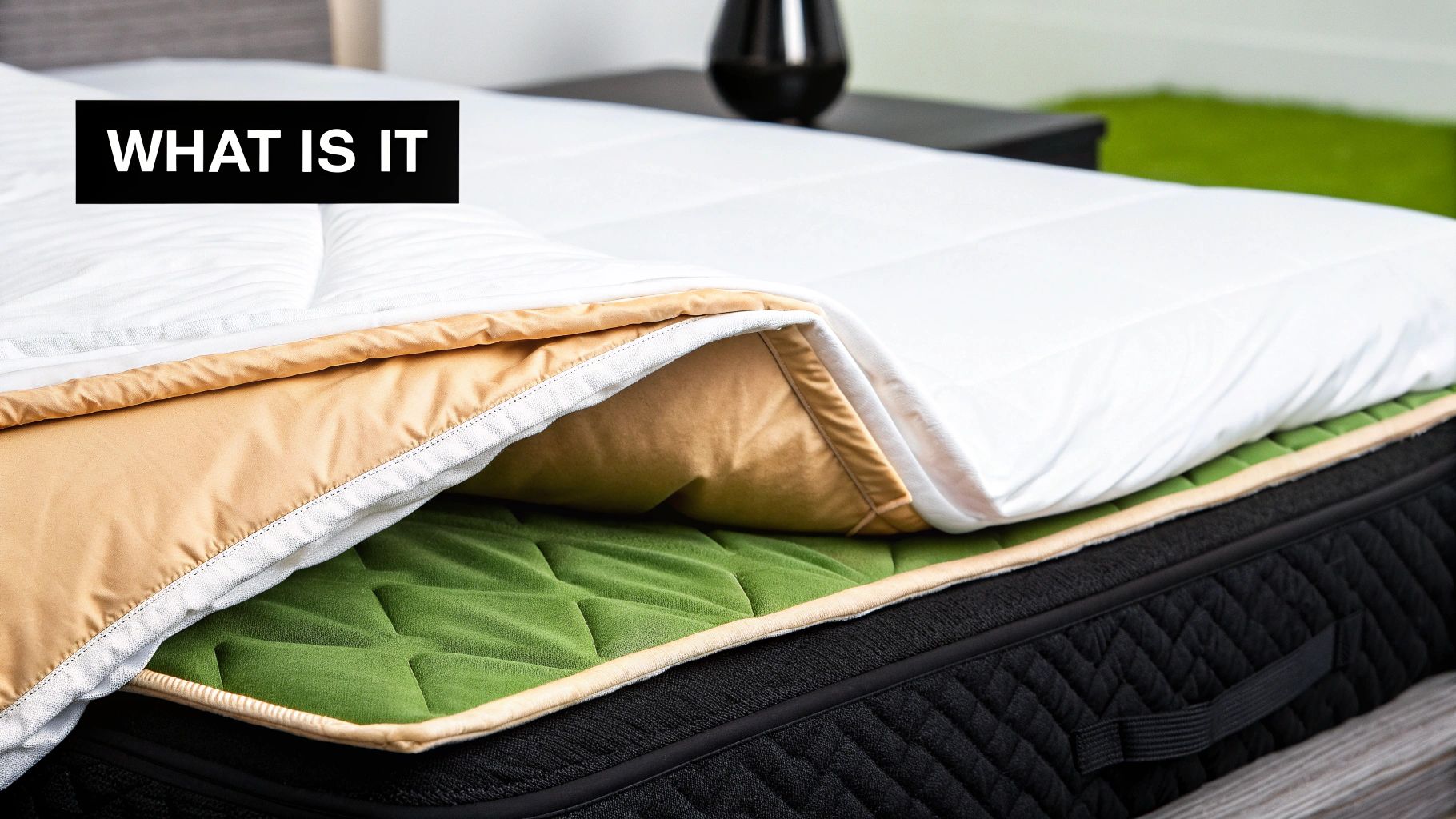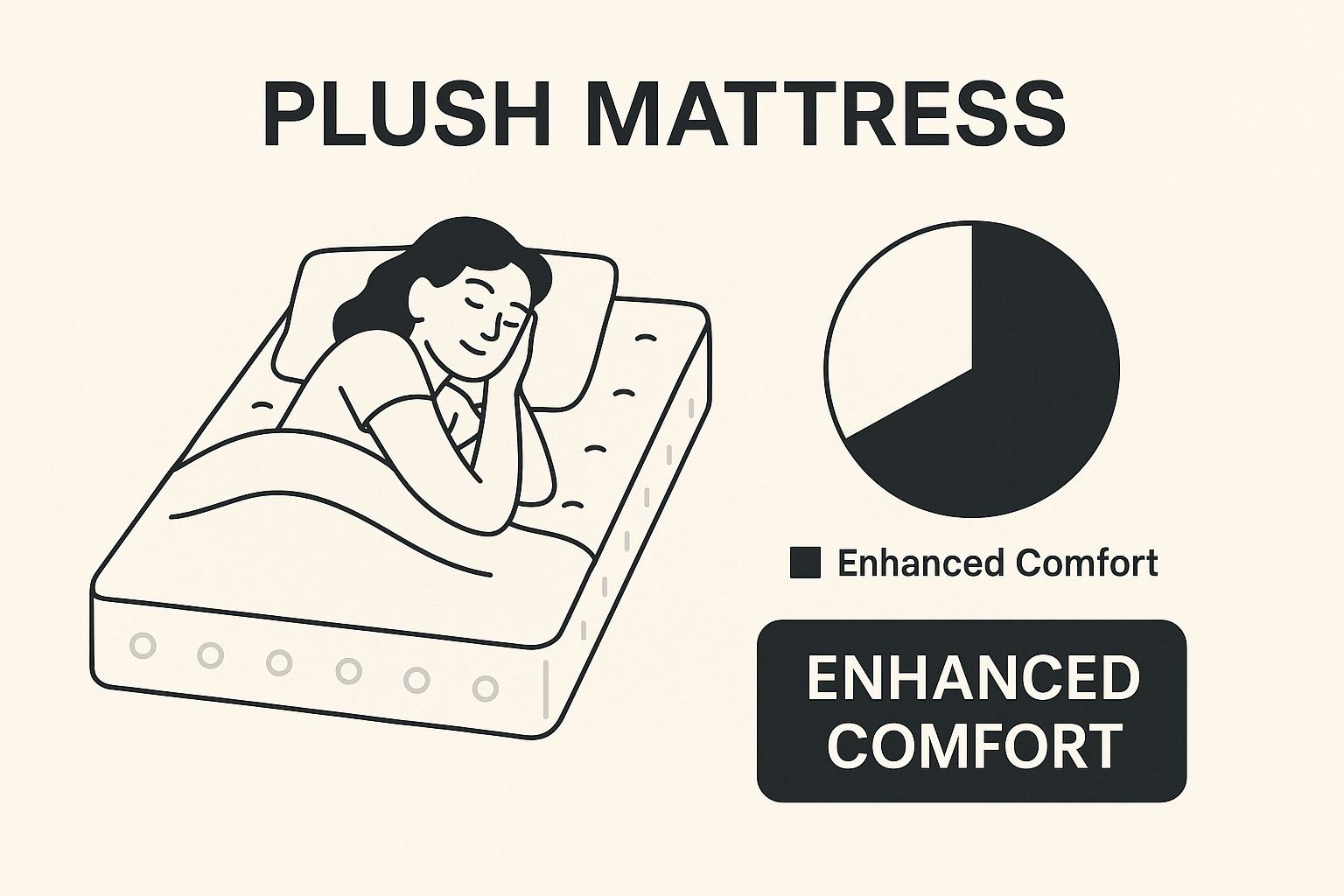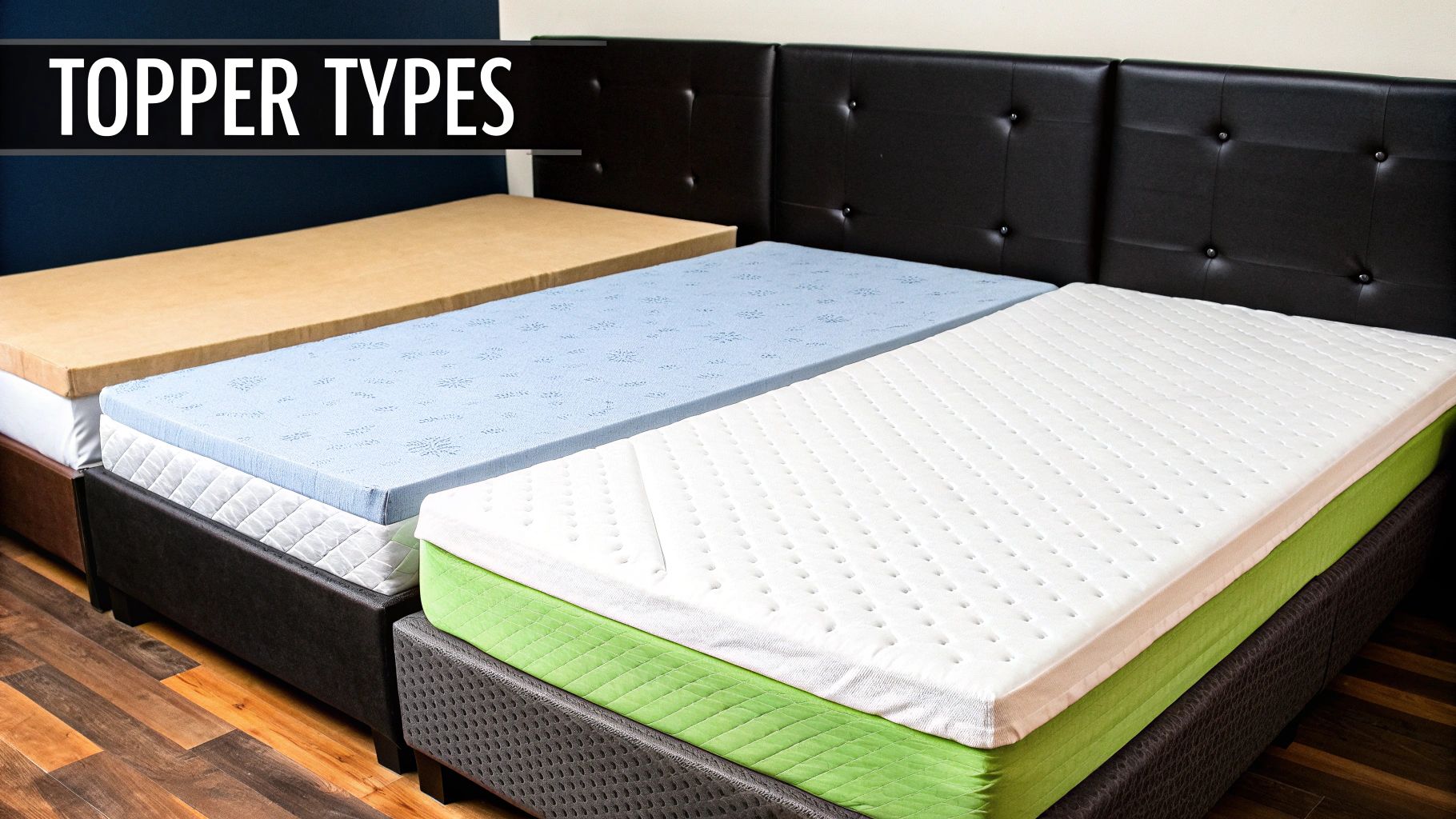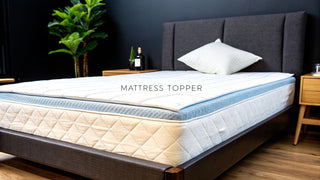Ever felt your bed was just missing something? You don't need a brand-new mattress for a five-star hotel sleep. The secret is often a simple, yet game-changing, layer on top. So, what is a mattress topper? It's a layer of cushioning you place on your existing mattress to instantly change its feel—making it softer, more supportive, or even cooler. It's the fastest way to upgrade your sleep.
What Is a Mattress Topper and Why Do You Need One?
Think of a mattress topper as a shortcut to a custom-made bed. Its job isn't to fix a completely worn-out, sagging mattress, but to fine-tune and enhance the one you have. It’s a clever, budget-friendly way to solve common sleep problems without the expense of a new mattress.

For example, if your new mattress is firmer than you expected, a 5-7cm memory foam topper can add a welcome layer of pressure-relieving softness. Conversely, if your bed feels too soft, a firm latex topper can add that extra support you crave. Research shows that the right sleep surface significantly impacts sleep quality, and a topper is a direct way to adjust yours.
What a Topper Actually Does
A mattress topper has a few key jobs, all designed to give your sleep an immediate boost. It’s the perfect solution for:
- Adjusting Firmness: Whether your bed is too hard or too soft, the right topper helps you dial in the surface feel to match your personal preference.
- Adding Pressure Relief: Materials like memory foam are brilliant at contouring to your body, easing pressure on joints like your hips and shoulders.
- Enhancing Support: A denser topper can introduce a much-needed supportive layer, promoting better spinal alignment as you sleep.
It acts as a buffer between you and your mattress, taking the brunt of nightly wear while delivering a noticeable upgrade in comfort. You can explore a wide variety of premium mattress toppers to find the perfect fit for your sleep needs.
A Guide to Common Mattress Topper Materials
Choosing the right mattress topper comes down to the material. Each one offers a different experience, so knowing the options is your first step toward transforming your bed. From the slow-sinking contour of memory foam to the springy lift of latex, the right material can turn an average mattress into your personal sleep sanctuary.

Memory Foam: The Pressure-Relieving Hug
Memory foam is famous for the way it contours to your body. Think of it as a slow, supportive hug that cradles your joints. It uses your body heat to soften and mould to your unique shape, which helps distribute your weight perfectly. This makes it a dream come true for side sleepers who need extra cushioning for their hips and shoulders. You can read about the benefits of memory foam for better sleep to understand its advantages fully.
Latex: The Responsive And Bouncy Lift
If memory foam is a hug, then latex is a gentle lift. Natural latex toppers have a much more buoyant and responsive feel, meaning they spring back into shape almost instantly. This is great for anyone who feels "stuck" in their bed, as it makes moving around effortless.
Latex is also naturally breathable and durable, making it a fantastic choice for:
- Hot Sleepers: Its open-cell structure lets air flow freely, helping to keep you cool.
- Eco-Conscious Shoppers: Natural latex is a sustainable and biodegradable option.
- Combination Sleepers: The springy feel makes it easy to shift positions without a struggle.
Feather And Down: The Cloud-Like Softness
For that classic, five-star hotel feeling, nothing matches a feather and down topper. These create an incredibly plush, cloud-like surface that you can sink into. They are exceptionally soft and lightweight, offering an unbeatable level of cosy comfort. A feather and down topper is less about changing support and more about adding a thick layer of pure, luxurious softness.
Wool And Polyester: The Balanced All-Rounders
Wool is a brilliant natural material that excels at temperature regulation. It has a remarkable ability to wick away moisture, keeping you warm in winter and cool in summer. Wool toppers provide a soft yet resilient surface with gentle cushioning.
Polyester blends (also known as microfibre) are a fantastic budget-friendly alternative. They are designed to mimic the soft, airy feel of down at a more accessible price. While not as long-lasting as latex or memory foam, a good quality polyester topper can still give a serious comfort boost, especially for a guest bed. Many people find a specialised cooling mattress topper made from modern blends strikes the perfect balance.
Mattress Topper Material Comparison
| Material | Primary Benefit | Feel | Best For |
|---|---|---|---|
| Memory Foam | Pressure Relief | Contouring, slow-sinking | Side sleepers and those with joint pain. |
| Latex | Responsive Support | Bouncy, buoyant | Hot sleepers and combination sleepers. |
| Feather & Down | Plush Softness | Cloud-like, light, airy | Those wanting a luxury, hotel-bed feel. |
| Wool | Temperature Regulation | Soft but resilient | Sleepers wanting natural, all-season comfort. |
| Polyester | Affordability | Soft, mimics down | Guest beds or those on a tighter budget. |
This breakdown should give you a clearer idea of which material might be the perfect fit for you.
The Real-World Benefits of a Mattress Topper
Beyond just adding softness, a quality topper brings serious, real-world upgrades to your sleep—the kind you’ll feel from the first night. Think of it as a smart, affordable investment in your comfort and wellbeing.

Enhanced Comfort and Support
The most immediate benefit is a massive leap in comfort. Let's say your mattress feels as unforgiving as a plank of wood. Adding a plush memory foam topper can transform that hard surface into a pressure-relieving haven that cradles your hips and shoulders. This is a game-changer for anyone dealing with aches. By providing an extra layer of contouring support, a topper helps keep your spine in proper alignment. Our guide on mattress toppers for bad backs explains how the right one can make a world of difference.
Extend Your Mattress Lifespan
A mattress is a big investment, and a topper is its best line of defence. The topper takes the hit from all the nightly wear and tear—your body weight, movement, and friction—that would otherwise wear down the mattress. By taking the brunt of the impact, a topper can add years to the life of your mattress, protecting your investment from premature sagging.
Improved Motion Isolation
If you share a bed, you know the struggle. Does every toss and turn from your partner send a ripple effect across the mattress? A quality foam or latex topper is brilliant at absorbing that movement. This means when one person moves, the other is far less likely to be jolted awake, leading to more peaceful, uninterrupted sleep for both of you.
Better Temperature Regulation
Waking up feeling hot and sticky ruins a good night's sleep. Many modern toppers are engineered to combat this problem.
- Gel-Infused Foam: These toppers have tiny gel beads that draw heat away from your body.
- Natural Latex: Its open-cell structure is naturally breathable, promoting constant airflow.
- Wool: This natural fibre is a master at wicking away moisture and regulating temperature.
Choosing a topper with cooling properties helps you maintain a consistent body temperature all night long.
How to Choose the Right Mattress Topper
Picking the right mattress topper is about pinpointing your specific sleep issues and matching them with the right solution. The first step is to take an honest look at your current bed.
Figure Out What Your Mattress is Lacking
Before you start browsing, identify the problem with your current mattress.
- Is it too firm? If you wake up with achy shoulders or hips, your goal is pressure relief. You'll need a topper that offers a generous layer of cushioning.
- Is it too soft? If you feel like you’re sinking with zero support, your goal is to add firmness. A dense, responsive topper is what you should look for.
- Do you sleep hot? If you constantly throw off the blankets, your mission is temperature regulation. Hunt for materials designed to keep you cool.
Once you’ve identified the problem, your goal becomes clear and narrows down your options.
Match Your Goal to the Right Features
With a clear goal, it's time to connect it to the specifics—material, thickness, and density.
- For Softness & Pressure Relief: A memory foam or feather and down topper is perfect. Look for a thickness between 7.5cm to 10cm for deep, luxurious cushioning.
- For Firmness & Support: A high-density latex or a firm memory foam topper is your best bet. A 5cm thickness is often enough to add a supportive layer.
- For Cooling: Look for gel-infused foam, natural latex, or wool. These materials promote airflow and wick heat away from your body.
Understanding Thickness and Density
Thickness and density are two critical factors that are easily confused.
Thickness, measured in centimetres (cm), determines how much the topper will change the feel of your mattress. A 5cm topper gives a subtle upgrade, whereas a 10cm one will completely transform your bed. Side sleepers and heavier individuals often benefit from thicker toppers for extra cushioning.
Density, measured in kilograms per cubic metre (kg/m³), is about support and durability. Higher-density foams (64 kg/m³ or more) provide better support and hold their shape for years. Lower-density foams are softer but can develop body indentations sooner. You can find more guidance on selecting comfortable sleep surfaces that balance these same principles.
Making Your Mattress Topper Last Longer
A quality mattress topper is an investment in your sleep, so it makes sense to get as many years out of it as you can. A few simple habits are all it takes to keep it comfortable and supportive.
To prevent permanent body impressions from forming, rotate your topper 180 degrees (head to foot) every two or three months. This simple move stops one spot from taking all the pressure night after night.
Cleaning and Freshness Tips
Spills and accidents happen, but they don't have to ruin your topper. Knowing how to clean the specific material is key.
- Memory Foam and Latex: Never soak these materials. Spot-clean stains by dabbing the area gently with a damp cloth and a mild detergent. Air dry completely before remaking the bed.
- Feather, Wool, or Polyester: Many of these can be machine-washed, but always read the care label first. Use a gentle cycle with a small amount of detergent.
A great trick for keeping any topper fresh is to air it out. On a dry, sunny day, strip the bed and let the topper breathe for a few hours to get rid of moisture or odours.
The Ultimate Protection Strategy
The single best thing you can do for your topper is to cover it with a thin, waterproof mattress protector. This creates a barrier against spills, sweat, dust mites, and allergens. It’s a small extra cost that provides total peace of mind and makes cleaning up messes a breeze. For more tips on looking after your entire sleep setup, check out our guide on 6 ways to make your bedding last longer.
Answering Your Top Mattress Topper Questions
Even with all the info, you might still have questions. Let's tackle some of the most common queries we hear about what a mattress topper is and does.
What Is The Difference Between a Topper and a Protector?
This is a common point of confusion. A topper is for comfort, while a protector is for preservation.
- A mattress topper is a thick layer of cushioning (5-10cm) that alters the feel of your mattress—making it softer, firmer, or more supportive.
- A mattress protector is a thin, often waterproof, sheet. Its only purpose is to shield your mattress and topper from spills, dust mites, and allergens.
You add a topper to change how your bed feels, and you put a protector over everything to safeguard that investment.
Can a Mattress Topper Fix a Sagging Mattress?
Unfortunately, the answer is no. A topper is a fantastic fix for a mattress that's too firm or has lost some plushness, but it can't fix major structural damage. When a mattress sags, its core support system has failed. Putting a topper on a sagging mattress is like putting a rug over a broken floorboard—it hides the problem momentarily but won’t fix the underlying issue. The topper will just sink into the dip, and you still won't get the support you need.
How Thick Should My Mattress Topper Be?
The right thickness depends on what you want to achieve.
If you're looking for a little extra softness on a good mattress, a 5cm topper will likely do the trick. It adds a lovely layer of cushioning without a drastic change.
However, if you're trying to salvage a very firm mattress or you're a side sleeper needing serious pressure relief, look at a 7.5cm or 10cm topper. These thicker options deliver deep, sink-in luxury and can truly overhaul the feel of your bed. Heavier people also tend to do better with thicker toppers for more substantial support.
A great night's sleep is not a luxury, it's a necessity. Upgrading your comfort with the right mattress topper is one of the easiest and most effective ways to improve your rest and overall wellbeing. Ready to feel the difference a premium topper can make?
Explore our collection and find your perfect mattress topper today!

